Multiple dashboards
You can define multiple dashboards in Home Assistant. Each dashboard can be added to the sidebar. This makes it possible to create separate control dashboards for each individual part of your house.
Under Settings > Dashboards, you can see your own dashboards as well as the predefined, built-in dashboards.
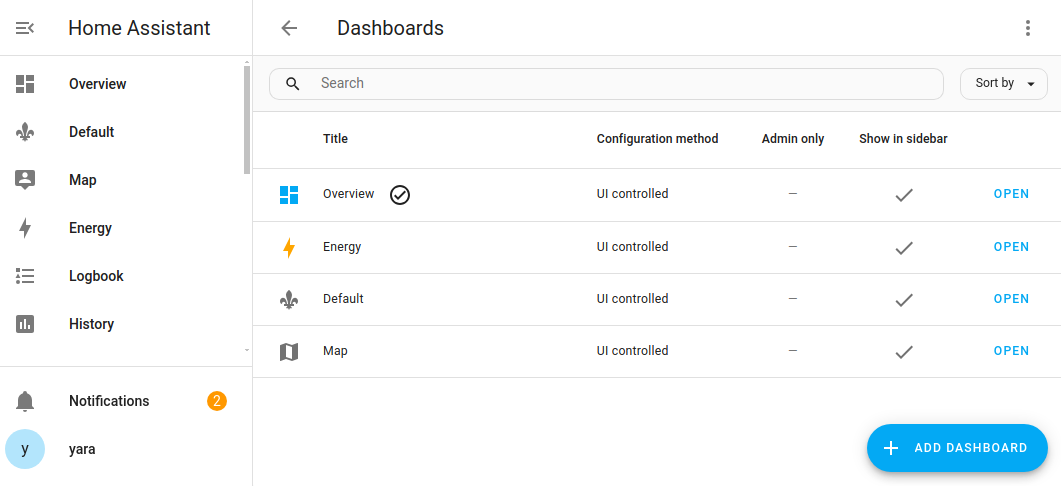 Screenshot of the Dashboard list.
Screenshot of the Dashboard list.
Home Assistant built-in dashboards
Built-in dashboards are available out of the box, cannot be deleted, and there are limited options on how much you can edit them.
Dashboards shown in the sidebar by default
Built-in dashboards that are available in the sidebar by default:
- Activity dashboard Category: built-in.
- Energy dashboard. Category: built-in.
- History dashboard. Category: built-in.
- Map dashboard: Category: user-created. The Map dashboard is an exception: it is available out of the box, but you can edit it freely. This is why it is categorized as User-created dashboard.
- Overview dashboard. Category: built-in.
- To-do lists dashboard. Category: built-in.
 Screenshot of the Dashboard list on a new installation.
Screenshot of the Dashboard list on a new installation.
Dashboards only shown in the dashboard list by default
Some of the built-in dashboards are not shown in the sidebar by default, but are listed under Settings > Dashboards.
- Home dashboard
- Lights dashboards: Overview of your lights, grouped by floors and areas.
- Security dashboards: Overview of your security-related devices, grouped by floors and areas. The security-related devices include devices such as alarm, lock, camera, doors/covers, motion sensors, and binary sensor.
- Climate dashboards: Overview of your climate devices, grouped by floors and areas. The climate dashboard includes devices such as heating and cooling devices, windows, and fans.
- Energy dashboards: Allows you to visualize your energy consumption and production, if you have such entities available. This includes electricity from grid and from solar panels, gas and water consumption, and the status of your battery storage.
Not all of the predefined dashboards are listed under Settings > Dashboards. The Activity and History dashboards for example are powered by their respective integrations.
Home dashboard
The Home dashboard is an entry point to open other built-in dashboards based on areas or topics such as lights, climate, or media players.
The Home dashboard is prepopulated by default and shows your entitiesAn entity represents a sensor, actor, or function in Home Assistant. Entities are used to monitor physical properties or to control other entities. An entity is usually part of a device or a service. [Learn more] grouped by areas.
- It uses the sections view type and tile cards.
- The first view shows all your areas and the entitiesAn entity represents a sensor, actor, or function in Home Assistant. Entities are used to monitor physical properties or to control other entities. An entity is usually part of a device or a service. [Learn more] that are assigned to those areas.
- In addition, the dashboard provides a separate view for each area.
- EntitiesAn entity represents a sensor, actor, or function in Home Assistant. Entities are used to monitor physical properties or to control other entities. An entity is usually part of a device or a service. [Learn more], such as lights, covers, and cameras are automatically grouped by domainEach integration in Home Assistant has a unique identifier: The domain. It is often shown as the first part (before the dot) of entity IDs..
 Screenshot of the built-in Home dashboard.
Screenshot of the built-in Home dashboard.
Editing the Home dashboard
- Make sure all the entitiesAn entity represents a sensor, actor, or function in Home Assistant. Entities are used to monitor physical properties or to control other entities. An entity is usually part of a device or a service. [Learn more] are assigned to an area.
- In the top-right corner, select the
icon. - You can add entities to customize which items appear on your dashboard.
- If you don’t like how the cards are arranged, you can reorder floors and areas under Settings > Areas, labels & zones.
Troubleshooting: entity is not showing
- Not all devices or entity types are automatically added to the Home dashboard.
- Make sure the entity is assigned to an area and check the dashboard again.
History dashboard
The predefined History dashboard is powered by the History integration. To learn about the data sources used and how to export data, refer to the documentation of the History integration.
Activity dashboard
The predefined Activity dashboard is powered by the Activity integration. To control which events to show or filter out, refer to the documentation of the Activity integration.
Map dashboard
The predefined Map dashboard is populated by the Map card. You can edit this dashboard like any other dashboard. For example, you can edit the view to use the Sidebar instead of the default Panel view type if you like.
Maps and presence detection
If you see a person on the map, it means you have connected a device that allows presence detection. This is the case for example if you have the Home Assistant Companion App on your phone and allowed location tracking.
To-do lists dashboard
The predefined To-do lists dashboard is powered by the To-do integration. To learn how to use to-do and shopping lists, refer to the documentation of the to-do list integration.
Webpage dashboard
Another available (but not default) dashboard is the webpage dashboard. The webpage dashboard allows you to add and embed a webpage to your dashboard. This could be a web page from the internet or a local web page from a local machine or device like your router or NAS. The webpage dashboard uses the webpage card.
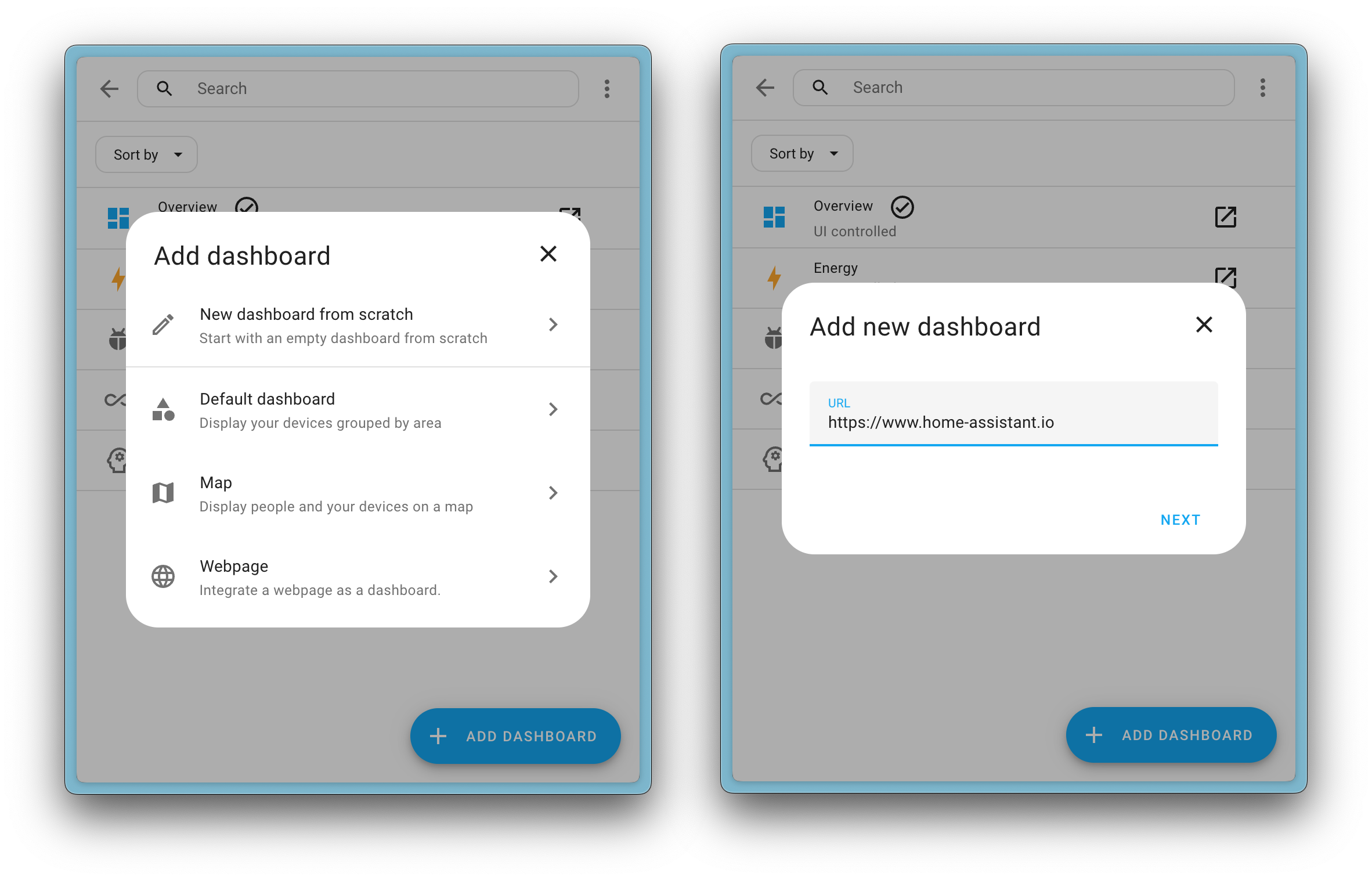
This dashboard replaces the old iFrame panel (iframe_panel). If you have
existing panels configured in your YAML configuration, Home Assistant will
automatically migrate them to the new webpage dashboard on upgrade.
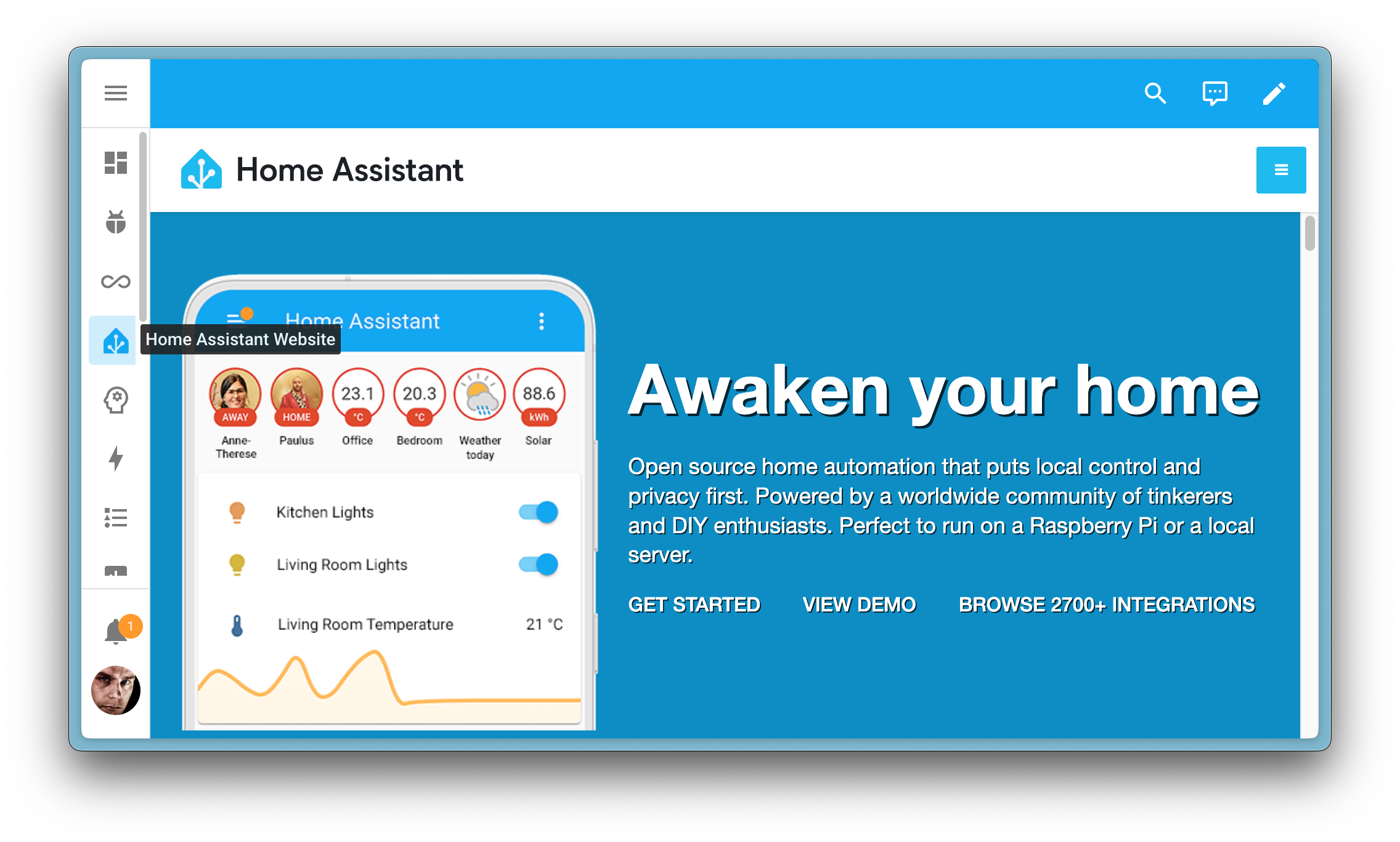
Note that not every webpage can be embedded due to security restrictions that some sites have in place. These restrictions are enforced by your browser and prevent embedding them into a Home Assistant dashboard.
Setting a default dashboard
The default dashboard is the dashboard that is shown when you open Home Assistant. It is listed on top of the sidebar.
- If you have administrator rights, you can set an initial default dashboard for all users.
-
Go to Settings > Dashboards.
-
In the list of dashboards, find the dashboard of interest and select the
menu. -
Select Set as default.
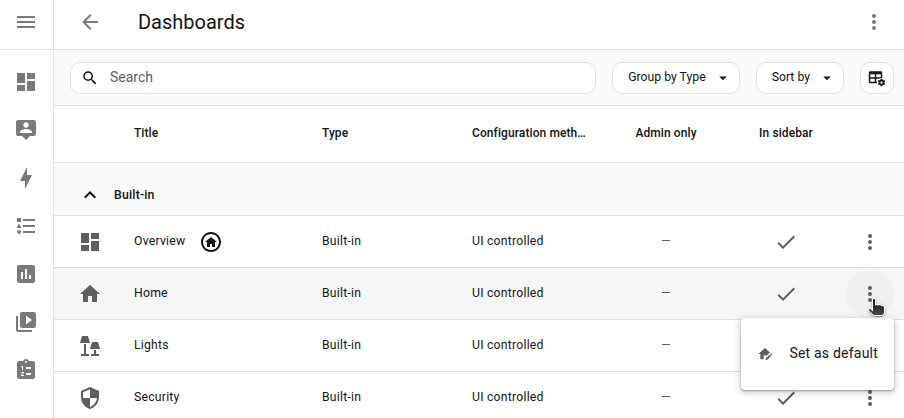
-
Result: This dashboard is shown to all users when they open Home Assistant.
-
- To change your personal default dashboard, you don’t need administrator rights.
-
Go to User profile.
-
On the General tab, under Dashboard, select your default dashboard.
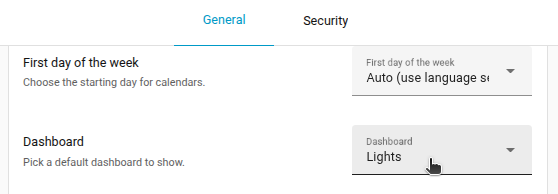
-
If you want your wall tablet to use a different dashboard than your other devices, use a separate user profile for your wall tablet.
- If you set your phone to one dashboard and your wall tablet to another, using the same user, they’ll both revert to the default dashboard.
-
Creating a new dashboard
The built-in dashboards update themselves when you add new devices. If you want a customized dashboard, it is recommended not to change the Overview dashboard, but to create a new dashboard instead.
This will leave the default dashboard intact.
-
Go to Settings > Dashboards.
-
Select Add dashboard.
-
In the dialog, choose one of the options:
- If you want to start with a pre-populated dashboard, choose Overview or one of the suggested ones, such as the Map dashboard.
- If you want to start with a completely empty dashboard, choose New dashboard from scratch.

-
In the Add new dashboard dialog, enter a name and select an icon.
- Define if this dashboard should be visible only to the admin user.
- Define if you want the dashboard to be listed in the sidebar.
- Select Create.
- Result: The dashboard is added.
Editing a new dashboard
-
Open your new dashboard and in the top right of the screen, select the
button. - Result: The Edit dashboard dialog appears.
-
Select the areas you want to show on this new dashboard and select Save.
-
If you want to have more detailed control over the dashboard, you need to take control:
- This means that this dashboard is no longer automatically updated when new dashboard elements become available.
- Once you’ve taken control, you can’t get this specific dashboard back to update automatically. However, you can create a new default dashboard.
- To continue, in the dialog, select the three dots
menu, then select Take control.
-
You can now add a badge, add a card, or add a view.
-
To undo or redo a change, select the buttons on top of the dashboard.

Deleting a dashboard
If you do not use one of the predefined dashboards, or created a dashboard you no longer need, you can delete that dashboard. It will then no longer show in the sidebar.
- Go to Settings > Dashboards.
- From the list of dashboards, select the dashboard you want to delete.
- In the dialog, select Delete.

Using YAML for the Overview dashboard
To change the Overview dashboard, create a new file ui-lovelace.yaml in your configuration directory and add the following section to your configuration.yaml and restart Home Assistant:
lovelace:
mode: yaml
A good way to start this file is to copy and paste the “Raw configuration” from the UI so your manual configuration starts the same as your existing UI.
- In your sidebar, select Overview.
- In the top-right corner, select the pencil icon.
- Select the three dots
menu and select Raw configuration editor. - There you see the configuration for your current dashboard. Copy that into the
<config>/ui-lovelace.yamlfile.
Once you take control of your UI via YAML, the Home Assistant interface for modifying it won’t be available anymore, and new entities will not automatically be added to your UI.
When you make changes to ui-lovelace.yaml, you don’t have to restart Home Assistant or refresh the page. Just hit the refresh button in the menu at the top of the UI.
To revert back to using the UI to edit your dashboard, remove the lovelace section from your configuration.yaml and copy the contents of your ui-lovelace.yaml into the raw configuration section of Home Assistant and restart.
Adding more dashboards with YAML
It is also possible to use YAML to define multiple dashboards. Each dashboard will be loaded from its own YAML file.
lovelace:
mode: yaml
# Include external resources only add when mode is yaml, otherwise manage in the resources in the dashboard configuration panel.
resources:
- url: /local/my-custom-card.js
type: module
- url: /local/my-webfont.css
type: css
# Add more dashboards
dashboards:
lovelace-generated: # Needs to contain a hyphen (-)
mode: yaml
filename: notexist.yaml
title: Generated
icon: mdi:tools
show_in_sidebar: true
require_admin: true
lovelace-hidden:
mode: yaml
title: hidden
show_in_sidebar: false
filename: hidden.yaml
You can also add YAML dashboards when your main dashboard is UI configured:
lovelace:
mode: storage
# Add yaml dashboards
dashboards:
lovelace-yaml:
mode: yaml
title: YAML
icon: mdi:script
show_in_sidebar: true
filename: dashboards.yaml
Configuration Variables
List of resources that should be loaded. Only use this when mode is yaml. If you change anything here, click the three dots Reload resources to pick up changes without restarting Home Assistant. You can also call lovelace.reload_resources action directly.
Additional YAML dashboards. The key is used for the URL and should contain a hyphen (-)
The mode of the dashboard, this should always be yaml. Dashboards in storage mode can be created in the configuration panel.
The file in your config directory where the configuration for this panel is.
The icon to show in the sidebar. You can use any icon from Material Design Iconsmdi:, ie mdi:home.
As a super minimal example of a dashboard config, here’s the bare minimum you will need for it to work:
views:
# View tab title.
- title: Example
cards:
# The markdown card will render markdown text.
- type: markdown
title: Dashboard
content: >
Welcome to your **dashboard**.
A slightly more advanced example:
views:
# View tab title.
- title: Example
# Unique path for direct access /lovelace/${path}
path: example
# Each view can have a different theme applied. Theme should be defined in the frontend.
theme: dark-mode
# The cards to show on this view.
cards:
# The filter card will filter entities for their state
- type: entity-filter
entities:
- device_tracker.paulus
- device_tracker.anne_there
state_filter:
- 'home'
card:
type: glance
title: People that are home
# The picture entity card will represent an entity with a picture
- type: picture-entity
image: https://www.home-assistant.io/images/default-social.png
entity: light.bed_light
# Specify a tab icon if you want the view tab to be an icon.
- icon: mdi:home-assistant
# Title of the view. Will be used as the tooltip for tab icon
title: Second view
cards:
# Entities card will take a list of entities and show their state.
- type: entities
# Title of the entities card
title: Example
# The entities here will be shown in the same order as specified.
# Each entry is an entity ID or a map with extra options.
entities:
- light.kitchen
- switch.ac
- entity: light.living_room
# Override the name to use
name: LR Lights
# The markdown card will render markdown text.
- type: markdown
title: Dashboard
content: >
Welcome to your **dashboard**.